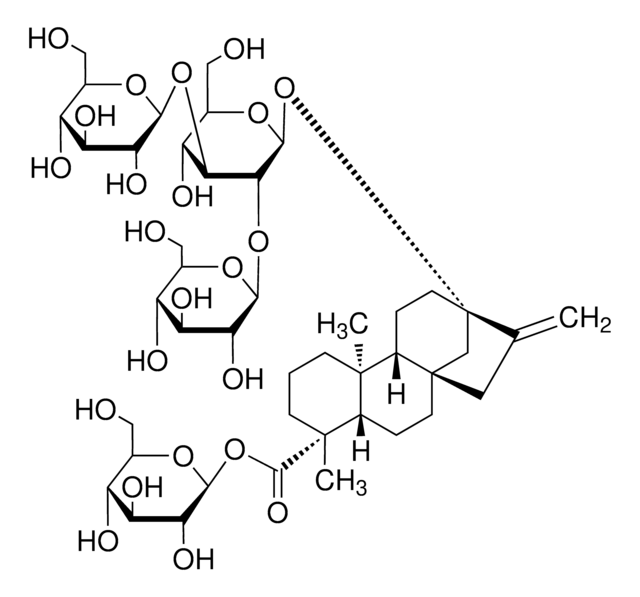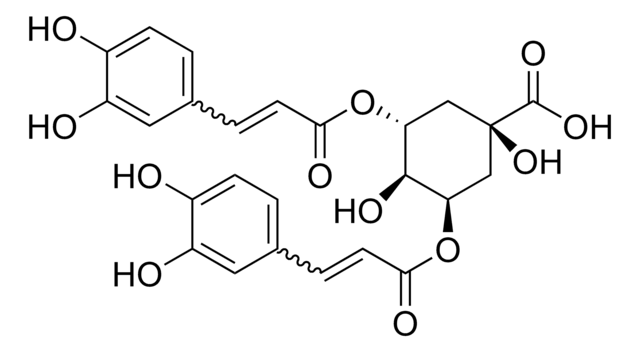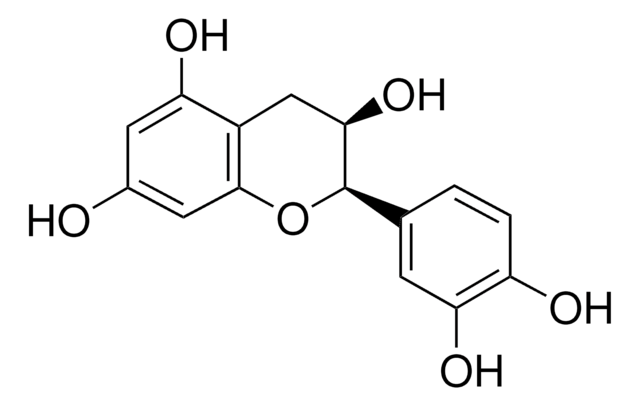15029
Caftaric acid
≥97.0%
Sinónimos:
2-Caffeoyl-L-tartaric acid
About This Item
Productos recomendados
Análisis
≥97.0%
formulario
powder
impurezas
≤10% water
aplicaciones
metabolomics
vitamins, nutraceuticals, and natural products
temp. de almacenamiento
2-8°C
cadena SMILES
O[C@H]([C@@H](OC(=O)\C=C\c1ccc(O)c(O)c1)C(O)=O)C(O)=O
InChI
1S/C13H12O9/c14-7-3-1-6(5-8(7)15)2-4-9(16)22-11(13(20)21)10(17)12(18)19/h1-5,10-11,14-15,17H,(H,18,19)(H,20,21)/b4-2+/t10-,11-/m1/s1
Clave InChI
SWGKAHCIOQPKFW-JTNORFRNSA-N
¿Está buscando productos similares? Visita Guía de comparación de productos
Categorías relacionadas
Descripción general
Aplicación
- as a standard antioxidant to determine the antioxidant potential (AOP) of red wine using 2,2-diphenyl-1-picrylhydrazyl (DPPH) assay
- as an antioxidant together with sulfur dioxide (SO2) to measure the antioxidant potential of white wines using 2,2-diphenyl-1-picrylhydrazyl (DPPH) and Folin-Ciocalteu (FC) assays
- to evaluate the myelopoietic effect on bone marrow of rats treated with various Echinacea purpurea extracts
- to identify (poly)phenolic compounds in concord grape juice and their metabolites in human plasma and urine after juice consumption
Acciones bioquímicas o fisiológicas
Envase
Código de clase de almacenamiento
11 - Combustible Solids
Clase de riesgo para el agua (WGK)
WGK 3
Punto de inflamabilidad (°F)
Not applicable
Punto de inflamabilidad (°C)
Not applicable
Equipo de protección personal
Eyeshields, Gloves, type N95 (US)
Certificados de análisis (COA)
Busque Certificados de análisis (COA) introduciendo el número de lote del producto. Los números de lote se encuentran en la etiqueta del producto después de las palabras «Lot» o «Batch»
¿Ya tiene este producto?
Encuentre la documentación para los productos que ha comprado recientemente en la Biblioteca de documentos.
Los clientes también vieron
Protocolos
HPLC Analysis of Polyphenols in Nero d'Avola Red Wine on Discovery® HS C18 (UV 280 nm)
Nuestro equipo de científicos tiene experiencia en todas las áreas de investigación: Ciencias de la vida, Ciencia de los materiales, Síntesis química, Cromatografía, Analítica y muchas otras.
Póngase en contacto con el Servicio técnico













